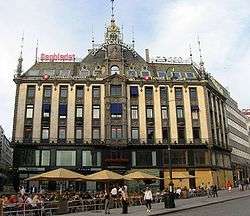Christian Fürst
Christian Fürst (15 April 1860 - 8 January 1910) was a Norwegian architect.[1]

Personal life
Christian Fürst was a Norwegian architect, born in Christiania (now Oslo), Norway on April 15, 1860 and died, on the 8th of January in 1910. He lived in Norway throughout his entire life and was responsible for designing at least four buildings. He was born to Hans Siegwardt Fürst (1826-94) and Anna Catherine Thalette Backer (1834-1921). One of three brothers, Valentin Fürst, Sr. (1870-1961), and Hans Siegwardt Backer Fürst (1877-1945), Christian Fürst joined his brother Hans in the business of architecture. During this time Norway was poverty stricken and undergoing much turmoil in relation to territory and independence lost to Denmark. Christianity had just made its shift over the area and this influenced many. This also marked a large immigration period for the people of Norway outside of their country.[2] Through the former, he was an uncle of film director Walter Fyrst ( 1901-1993) and physician Valentin Fürst, Jr .[3]
Career
Fürst attended Kristiania Technical School, now known as Oslo University College, in addition to the Technical School of Berlin and graduated in 1882. He was an assistant to professor Johannes Otzen, a well known German Architect known for his gothic style of buildings. He assisted Otzen up until 1885. After living in Kristiania for a while, Fürst decided to return to Berlin and attend the Academy of the Arts (Königliche Akademie der Künste zu Berlin) from 1889 to 1891. This was popular amongst Norwegian Scholars to go and stud in major cities like Berlin to escape the impoverished areas of Norway. He was also an assistant of architect Paul Wallot until 1892, when he returned to Norway. He opened an architectural firm in Kristiania in 1896. His brother, Hans Backer Fürst, became a partner in 1902.[4] [5][6]
Style
Fürst’s style of architecture can be notably characterized under the term, “gothic”. This style of architecture arose primarily in the middle ages during the Renaissance era and was symbolically representative of Christianity.[7] One would see a large building with pointed spikes and decorative finishing and associate it with the church. Fürst however, started his career in architecture about a century after the renaissance had ended, and he had the idea of incorporating the gothic style into buildings other than churches. He is one of the many architects of this time held responsible to bringing the gothic style into Scandinavia from its origin of southern Europe.
A good example of this would be his business palace, “Tostrupgården”. This large elaborate building was primarily constructed out of marble, and resembled much of the gothic style buildings from the renaissance. Another one of his notable works was actually a church, the Sagene church, located in Oslo constructed in 1891. Norway in the 1800s was extremely Christian, thus explaining some of the influence behind Fürst’s work. His designed incorporated many of the notable gothic design features like flying buttresses, pointed arches, and large ornate windows. [8]
Among his notable works are Trinity Church (Trefoldighetskirken) in Arendal and Sagene Church in Oslo. Tostrupgården, a monumental business premises on Karl Johans Gate in Oslo, was built 1896-1898 in a cooperation with Waldemar Hansteen and Torolf Prytz.[9] [10] [11] He also participated in the rebuilding of Ålesund following the 1904 Ålesund Fire.[1]
References
- Henriksen, Petter, ed. (2007). "Christian Fürst". Store norske leksikon (in Norwegian). Oslo: Kunnskapsforlaget. Retrieved 12 April 2009.
- "Woldhagen.org: History of Norway". woldhagen.org. Retrieved 2018-10-25.
- Holck, Per. "Valentin Fürst". In Helle, Knut (ed.). Norsk biografisk leksikon (in Norwegian). Oslo: Kunnskapsforlaget. Retrieved 12 April 2009.
- "Otzen, Johannes". Deutsche Biographie. Retrieved September 1, 2017.
- Steigan, Geir Tandberg (2004). "Christian Fürst (1860-1910)" (in Norwegian). Arc!. Retrieved 12 April 2009.
- Geir Tandberg Steigan. "Hans Siegwardt Backer Fürst". artemisia.no. Retrieved September 1, 2017.
- "What impact did the Renaissance have on Christianity?". GotQuestions.org. Retrieved 2018-10-25.
- "Gothic Architecture: Style, Characteristics & History - Video & Lesson Transcript | Study.com". study.com. Retrieved 2018-10-25.
- "Trefoldighetskirken (Arendal)". lokalhistoriewiki.no. Retrieved September 1, 2017.
- Geir Tandberg Steigan. "Tostrupgården, Karl Johans gate 25". artemisia.no. Retrieved September 1, 2017.
- Indahl, Trond (2003). "Torolf Prytz". In Helle, Knut (ed.). Norsk biografisk leksikon (in Norwegian). 7. Oslo: Kunnskapsforlaget. Retrieved 12 April 2009.
| Wikimedia Commons has media related to Christian Fürst. |
- "Woldhagen.org: History of Norway". woldhagen.org. Retrieved 2018-10-25.